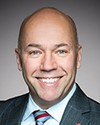I wanted to start off with my own thing.
[Witness speaks in Ojibwa]
I asked the spirit to forgive me, as I use English. I can only speak a little bit of my language, but I'm still learning. I acknowledge all of you and thank you for giving the time to hear me today.
My true identity is Standing White Bear. I come from Rat Portage First Nation just inside Treaty No. 3 territory, and I belong to the Lynx clan. Today, I am here representing the AFN to discuss our calls to action and discuss the grim circumstances that are facing our communities. Before I even really get into it, I'm sure you are aware that a 10-year-old girl took her own life earlier this week.
As we're sitting here talking today, these issues are very real and they're happening every single day, whether they be an attempt or a successful suicide. Our calls to action that I'll be presenting today reaffirm our treaty rights and their sacred relationship between the crown and our people. Our calls to action also communicate our ideas supporting life and reducing risks for suicide attempts among first nations children and youth.
I've been an Anishinaabe youth leader. It pains me. It absolutely crushes me to my core that there are children as young as 10 years old committing suicide. It pains me to know there are young mothers and fathers taking their own lives and leaving children behind with questions as to why their mom and dad are no longer with them, why they chose to leave that way, much like my sister-in-law who left behind my niece and nephew.
I attempted suicide in January 2016. These are things that are not happening to at-risk youth; they're not strictly related to them. These things are happening to people like me, with a strong cultural background, who grew up in a home with my family. There are deeper issues at work than the simple surface issues that we continue to look at, and that's what we need to try to address.
The responses from the previous government have really left me frustrated, and even now, as the youth councils across this nation try to work as hard as they can to address this issue. Because these suicides are nothing new. They've been affecting our nation for quite some time now, and these crises happen in cycles. With the lack of address from previous governments, and more understanding as to how or why these things are happening, it's easy to see why our relationship with the crown is as tense as it is now.
But, I will say there is hope, hope that we can come together and begin to realize that treaty relationship that our elders had envisioned many years ago; to not renew our partnership, but to get to that level of partnership where our people all across this nation, including the Canadian people, are strong. It's going to be the passion for our young people, the care for those young lives. They are going to help us get there.
The way forward requires a first nations' social determinant of health to be addressed. Health outcomes cannot be assessed by the health institutions alone. First nations people need to take a lead, and we are taking a lead in addressing these issues, but what we really need to start seeing is being able ourselves to control the resources and to have the freedom to develop the programs, using our framework of wellness and our frameworks of healing.
The way forward also requires a full implementation of the first nations mental wellness continuum framework. The framework outlines opportunities to build on community strengths and control of resources in order to improve existing mental wellness programming for first nations communities.
There is clear evidence that pride in one's identity can reduce suicide rates. I've picked up a lot of my language, more than I ever did. I'm starting to learn my ceremonies. I carry this with pride, to the person that I am: strong, healthy, and positive. My healing began in January 2016, and it's only October 2016. With my experiences I never thought I'd ever be in this position, or have these positive emotions back again. Yet, here I am, and I credit it to this most importantly. Because, as we all know, colonialism, residential schools, the sixties scoop, have left us disconnected from our lands, our identity, and our culture. When you look through our calls to action, you will see that we ask for those specific resources and programming to be allocated to supporting youth to reconnect with their culture, to find a way to reconnect with their language, their spirituality, and who they are, so that when they have that pride and that identity, that pride in themselves, they won't believe suicide is an option. They'll know where to go. They'll know that our lodges and our elders are our true mental wellness people, our healers, just like your psychologists and doctors. That is where we go, and that's where I went, and that's clear evidence that I'm doing much better.
I want to go through our calls to action with you point by point because I would do a disservice to the experiences of the youth who contributed to this if I just simplified it or bullet-pointed it or anything like that, so please bear with me.
One, a priority should be placed on taking immediate action to address growing inequities in education, employment, income, and healthy living environments. In keeping with a social determinants perspective, first peoples must control, design, and define their systems of health, education, and child welfare with funding that is at least equal to what all other Canadians receive.
Two, adequate and sustainable funding should be provided to ensure that a comprehensive range of culturally safe prevention, health promotion, and mental health treatment services are made available to all first nations communities.
Three, regular and accessible training opportunities should be made available to youth who want to learn how to be supportive peer mentors to other young people in their communities, such as safeTALK or ASIST training.
Four, adequate funding should be provided to enable young people to attend regional gatherings related to life promotion and suicide prevention. Young people need spaces to come together, be heard, and develop their helping skills.
Five, support should be provided to first nations communities so that elders and cultural advisers can provide cultural teachings that will enable young people to know where they come from, who they are, what their purpose is, and where they are going. This will help to re-establish the strengths of first peoples' cultural identity that are vital for reconciliation.
Six, culturally appropriate, land-based teachings and educational programs should be made available for all first nations children, youth, and young adults, including traditional language revitalization opportunities, since valuable ways of knowing come from speaking one's own language.
Seven, all government departments should work closely with indigenous leaders and local, provincial, and territorial governments to implement recommendations 6 to17, outlined in the TRC report.
Eight, specific efforts be made to re-establish relationships of equity and respect between first peoples and the crown. These forms of relationships are crucial to sustain and advance healthy communities. This is the foundation of reconciliation and health upon the land, Manitu-wakhi, Mother Earth.
Nine, education for first nations students should be inclusive of the values and beliefs of first nations communities as determined by first nations communities themselves. In this regard we envision a Canadian public education system that is inclusive and respectful of all Canadians' beliefs and values, as cultural safety dictates.
Ten, all Canadian children should learn about Canada's colonial roots and indigenous pre-contact history to advance the restoration of peaceful and equitable relationships between first peoples and the people of Canada.
Eleven, give programs that are proving to be successful in communities, of which there are plenty, and on our nations, increased and enhanced flexible funding.
In closing, as we sit around this table we must not only talk about our partnership on a nation-to-nation level, we must also begin acting on it. That sacred relationship must be re-established for the sake and well-being and health of our nations' young people.
As you look at our calls to action, keep this in mind. It was 143 years ago that Treaty 3 was signed. I'm a descendant of those signatories, here today talking about a crisis for our youth in our communities. For as long as I can remember, it's always been the young people who have faced the brunt of colonialism, when you look at residential schools, sixties scoop, suicides. It's been our young people in our communities who have faced the most hurt and have had to deal with that.
In keeping with that, my parents are survivors of a residential school. I am a father of a six-year-old girl. They apologized to me for not being the best parents that they could be. How could I have accepted that apology when I knew it was not their fault? It was that system.
I say that, keeping this in your minds. When we make decisions, when we come together as nations and leaders, we effectively make change for generations ahead. I say that in 143 years from now, when it's our future sitting in these chairs, let's not make them come here to talk about another cycle of suicide. When they come to this table again, let them say that we came together—the crown, our leaders, our youth, our elders—that we established a solid foundation of healing and well-being for the future generations, and that we did that together.
I leave that with you. Now that's up to you to come to us and determine, along with us, how that's going to look in the immediate future and in the long term. I thank you. Gichi meegwetch, again, for giving your energy and hearing these opening statements.



